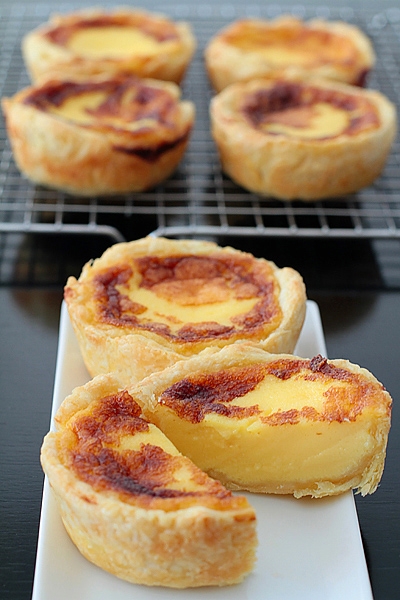
 Eggs – we used both whole eggs and egg yolks. Puff pastry – we bought ours ready at the freezer of our local grocery store but you’re welcome to make yours from scratch. I have a simpler approach! To me, they look like little rays of sunshine, and taste like heaven! I hope that they will for you as well… And The Guardian, the well-known British national newspaper, pronounced them as the 15th tastiest delicacy in the world. I grew up enjoying them all year round, sometimes by themselves and sometimes accompanied by a cup of café au lait.Īs a descendant of Portuguese ancestors, I imagine that it couldn’t have been any other way! But you know what? No matter where you go in Brazil, you will find the Portuguese pastel de nata in almost every café, bakery, or pastry shop – thank goodness!įolks, Portuguese custard tarts are so good that they have been designated as one of the 7 wonders of Portuguese cuisine. In my home country of Brazil, these Portuguese custard tarts have been a hit for a long, long time. It sells over 20,000 pastéis de nata a day! Portuguese enjoy sprinkling the top with ground cinnamon and powdered sugar, and often accompany the tarts with a bica (a strong espresso coffee). That secret recipe is recreated every day by hand, using only traditional methods. In Portugal, the original recipe for Pastéis de Belém were made in 1837 by the Antiga Confeitaria de Belém, simply known under the name Pastéis de Belém following an ancient recipe from the Jerónimos Monastery. The most popular egg tarts that everyone knows and loves are the Portuguese, Brazilian (similar to the Portuguese egg tarts), and the Chinese ones which don’t have a caramelized top. Moreover, they became a hit in mainland China and countries with significant Portuguese immigration such as Canada, Australia, Luxembourg, the United States, England (where is called maids of honour), and France, among others.īut if you go to the Azores, please call them by their proper name there: Queijadas de nata !
Eggs – we used both whole eggs and egg yolks. Puff pastry – we bought ours ready at the freezer of our local grocery store but you’re welcome to make yours from scratch. I have a simpler approach! To me, they look like little rays of sunshine, and taste like heaven! I hope that they will for you as well… And The Guardian, the well-known British national newspaper, pronounced them as the 15th tastiest delicacy in the world. I grew up enjoying them all year round, sometimes by themselves and sometimes accompanied by a cup of café au lait.Īs a descendant of Portuguese ancestors, I imagine that it couldn’t have been any other way! But you know what? No matter where you go in Brazil, you will find the Portuguese pastel de nata in almost every café, bakery, or pastry shop – thank goodness!įolks, Portuguese custard tarts are so good that they have been designated as one of the 7 wonders of Portuguese cuisine. In my home country of Brazil, these Portuguese custard tarts have been a hit for a long, long time. It sells over 20,000 pastéis de nata a day! Portuguese enjoy sprinkling the top with ground cinnamon and powdered sugar, and often accompany the tarts with a bica (a strong espresso coffee). That secret recipe is recreated every day by hand, using only traditional methods. In Portugal, the original recipe for Pastéis de Belém were made in 1837 by the Antiga Confeitaria de Belém, simply known under the name Pastéis de Belém following an ancient recipe from the Jerónimos Monastery. The most popular egg tarts that everyone knows and loves are the Portuguese, Brazilian (similar to the Portuguese egg tarts), and the Chinese ones which don’t have a caramelized top. Moreover, they became a hit in mainland China and countries with significant Portuguese immigration such as Canada, Australia, Luxembourg, the United States, England (where is called maids of honour), and France, among others.īut if you go to the Azores, please call them by their proper name there: Queijadas de nata ! 
I hope that this in itself is enough to make you smile!Īlthough created before the 19th century (1800’s) by Catholic monks in Lisbon, Portugal, these pasteis de nata quickly became quite popular in several Portuguese-speaking countries such as Brazil, Goa, and Macau, under the name of Portuguese Egg Tarts or Pastel de Ovo. Known as Pastel de Belém or more often Pastel de Nata (plural pastéis de nata) in Portuguese, it is a small tart made from puff pastry and a rich pastry cream with caramelized or burnt spots on top of the custard. There are several versions of the original and you are welcome to try any. I first featured a different version at Manu’s Menu as part of a guest post a few years ago. The result was excellent! The pastry crust is crispy and the custard is creamy and presents caramelized spots that are very characteristic of the original pastel de belém. Then we used a custard recipe that doesn’t need to cook on the stovetop like a regular pastry cream. To make the labor less intensive, we used a store-bought pastry dough which cuts the prep time quite a bit. Our recipe is the easy or shortcut version of that recipe. The original Portuguese egg tart recipe from the 19 th century is a real secret. This isn’t any ordinary tart! We are sharing with you one of the Seven Wonders of Gastronomy. If you have never had pastel de nata, this is your big chance.

This is the shortcut or easy dessert recipe that cuts the prep time quite a bit yet it tastes like the traditional treat. Pastel de nata (or Portuguese egg tart) is a 19 th century small tart with a crispy puff pastry crust and a custardy pastry cream filling, presenting caramelized spots on top.







 0 kommentar(er)
0 kommentar(er)
